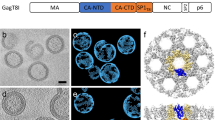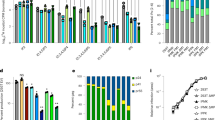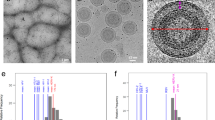Abstract
The major structural components of HIV-1 are encoded as a single polyprotein, Gag, which is sufficient for virus particle assembly. Initially, Gag forms an approximately spherical shell underlying the membrane of the immature particle. After proteolytic maturation of Gag, the capsid (CA) domain of Gag reforms into a conical shell enclosing the RNA genome. This mature shell contains 1,000–1,500 CA proteins assembled into a hexameric lattice with a spacing of 10 nm. By contrast, little is known about the structure of the immature virus. We used cryo-EM and scanning transmission EM to determine that an average (145 nm diameter) complete immature HIV particle contains ∼5,000 structural (Gag) proteins, more than twice the number from previous estimates. In the immature virus, Gag forms a hexameric lattice with a spacing of 8.0 nm. Thus, less than half of the CA proteins form the mature core.
This is a preview of subscription content, access via your institution
Access options
Subscribe to this journal
Receive 12 print issues and online access
$189.00 per year
only $15.75 per issue
Buy this article
- Purchase on Springer Link
- Instant access to full article PDF
Prices may be subject to local taxes which are calculated during checkout



Similar content being viewed by others
References
Wilk, T. et al. Organization of immature human immunodeficiency virus type 1. J. Virol. 75, 759–771 (2001).
Li, S., Hill, C.P., Sundquist, W.I. & Finch, J.T. Image reconstructions of helical assemblies of the HIV-1 CA protein. Nature 407, 409–413 (2000).
Ganser, B.K., Li, S., Klishko, V.Y., Finch, J.T. & Sundquist, W.I. Assembly and analysis of conical models for the HIV-1 core. Science 283, 80–83 (1999).
Briggs, J.A.G., Wilk, T., Welker, R., Krausslich, H.G. & Fuller, S.D. Structural organization of authentic, mature HIV-1 virions and cores. EMBO J. 22, 1707–1715 (2003).
Mayo, K. et al. Retrovirus capsid protein assembly arrangements. J. Mol Biol. 325, 225–237 (2003).
Nermut, M.V. et al. Further evidence for hexagonal organization of HIV gag protein in prebudding assemblies and immature virus like particles. J. Struct. Biol. 123, 143–149 (1998).
Cimarelli, A. & Darlix, J.L. Assembling the human immunodeficiency virus type 1. Cell Mol. Life Sci. 59, 1166–1184 (2002).
Frankel, A.D. & Young, J.A. HIV-1: fifteen proteins and an RNA. Annu. Rev. Biochem. 67, 1–25 (1998).
Wilk, T. & Fuller, S.D. Towards the structure of the human immunodeficiency virus: divide and conquer. Curr. Opin. Struct. Biol. 9, 231–243 (1999).
Turner, B.G. & Summers, M.F. Structural biology of HIV. J. Mol. Biol. 285, 1–32 (1999).
Piatak, M. et al. High-levels of HIV-1 in plasma during all stages of infection determined by competitive PCR. Science 259, 1749–1754 (1993).
Layne, S.P. et al. Factors underlying spontaneous inactivation and susceptibility to neutralization of human-immunodeficiency-virus. Virology 189, 695–714 (1992).
Zhu, P. et al. Electron tomography analysis of envelope glycoprotein trimers on HIV and simian immunodeficiency virus virions. Proc. Natl. Acad. Sci. USA 100, 15812–15817 (2003).
Vogt, V.M. & Simon, M.N. Mass determination of rous sarcoma virus virions by scanning transmission electron microscopy. J. Virol. 73, 7050–7055 (1999).
Wilk, T., Gowen, B.E. & Fuller, S.D. Actin associates with the nucleocapsid domain of the Gag polyprotein in the human immunodeficiency virus (HIV-1). J. Virol. 73, 1931–1940 (1999).
Accola, M.A., Strack, B. & Gottlinger, H.G. Efficient particle production by minimal gag constructs which retain the carboxy-terminal domain of human immunodeficiency virus type 1 capsid-p2 and a late assembly domain. J. Virol. 74, 5395–5402 (2000).
Johnson, M.C., Scobie, H.M., Ma, Y.M. & Vogt, V.M. Nucleic acid-independent retrovirus assembly can be driven by dimerization. J. Virol. 76, 11177–11185 (2002).
Zhang, Y.Q., Qian, H.Y., Love, Z. & Barklis, E. Analysis of the assembly function of the human immunodeficiency virus type 1 gag protein nucleocapsid domain. J. Virol. 72, 1782–1789 (1998).
Gamble, T.R. et al. Structure of the carboxyl-terminal dimerization domain of the HIV-1 capsid protein. Science 278, 849–853 (1997).
del Alamo, M., Neira, J.L. & Mateu, M.G. Thermodynamic dissection of a low affinity protein-protein interface involved in human immunodeficiency virus assembly. J. Biol. Chem. 278, 27923–27929 (2003).
Gross, I., Hohenberg, H., Huckhagel, C. & Krausslich, H.G. N-terminal extension of human immunodeficiency virus capsid protein converts the in vitro assembly phenotype from tubular to spherical particles. J. Virol. 72, 4798–4810 (1998).
Gross, I. et al. A conformational switch controlling HIV-1 morphogenesis. EMBO J. 19, 103–113 (2000).
Campbell, S. & Rein, A. In vitro assembly properties of human immunodeficiency virus type 1 Gag protein lacking the p6 domain. J. Virol. 73, 2270–2279 (1999).
Wall, J.S., Hainfeld, J.F. & Simon, M.N. Scanning transmission electron microscopy of nuclear structures. Methods Cell Biol. 53, 139–164 (1998).
Muller, B., Tessmer, U., Schubert, U. & Krausslich, H.G. Human immunodeficiency virus type 1 Vpr protein is incorporated into the virion in significantly smaller amounts than Gag and is phosphorylated in infected cells. J. Virol. 74, 9727–9731 (2000).
Franke, E.K., Yuan, H.E.H. & Luban, J. Specific incorporation of cyclophilin-A into HIV-1 virions. Nature 372, 359–362 (1994).
Freed, E.O. HIV-1 Gag protein: diverse functions in the virus life cycle. Virology. 251, 1–15 (1998).
Welker, R., Hohenberg, H., Tessmer, U., Huckhagel, C. & Krausslich, H.G. Biochemical and structural analysis of isolated mature cores of human immunodeficiency virus type 1. J. Virol. 74, 1168–1177 (2000).
Forshey, B.M. & Aiken, C. Disassembly of human immunodeficiency virus type 1 cores in vitro reveals association of Nef with the subviral ribonucleoprotein complex. J. Virol. 77, 4409–4414 (2003).
Lanman, J. et al. Key interactions in HIV-1 maturation identified by mass spectrometry based H/D exchange. Nat. Struct. Mol. Biol. 11, 676–677 (2004).
Fuller, S.D., Wilk, T., Gowen, B.E., Krausslich, H.G. & Vogt, V.M. Cryo-electron microscopy reveals ordered domains in the immature HIV-1 particle. Curr. Biol. 7, 729–738 (1997).
Press, W.H., Flannery, B.P., Teukolsky, S.A. & Vetterling, W.T. Numerical Recipes in Fortran 77 (Cambridge Univ. Press, Cambridge, UK, 1992).
Yu, F. et al. Characterization of Rous sarcoma virus Gag particles assembled in vitro. J. Virol. 75, 2753–2764 (2001).
Acknowledgements
We thank D.I. Stuart, E.Y. Jones, R. Matadeen, R.L. Kingston and R.J. Hurrelbrink for critical readings of the manuscript, D.I. Stuart and E.Y. Jones for discussions of diffraction analysis and K.V. Fernando for help with programming. The BNL STEM is a US National Institutes of Health (NIH) supported resource center, NIH P41–RR01777, with additional support provided by the US Department of Energy, Office of Biological and Environmental Research. This work was supported by a Wellcome Trust Programme Grant to S.D.F., a US Public Health Service grant to V.M.V. and a Deutsche Forschungsgemeinschaft grant to H.-G.K. J.A.G.B. holds a Wellcome Trust structural biology studentship. S.D.F. is a Wellcome Trust principal research fellow.
Author information
Authors and Affiliations
Corresponding author
Ethics declarations
Competing interests
The authors declare no competing financial interests.
Rights and permissions
About this article
Cite this article
Briggs, J., Simon, M., Gross, I. et al. The stoichiometry of Gag protein in HIV-1. Nat Struct Mol Biol 11, 672–675 (2004). https://doi.org/10.1038/nsmb785
Received:
Accepted:
Published:
Issue Date:
DOI: https://doi.org/10.1038/nsmb785
This article is cited by
-
A novel and robust method for counting components within bio-molecular complexes using fluorescence microscopy and statistical modelling
Scientific Reports (2022)
-
Rotten to the core: antivirals targeting the HIV-1 capsid core
Retrovirology (2021)
-
HIV-1 integrase binding to genomic RNA 5′-UTR induces local structural changes in vitro and in virio
Retrovirology (2021)
-
Impact of HIV-1 Vpr manipulation of the DNA repair enzyme UNG2 on B lymphocyte class switch recombination
Journal of Translational Medicine (2020)
-
Characterization of HIV-1 uncoating in human microglial cell lines
Virology Journal (2020)



